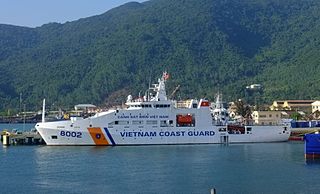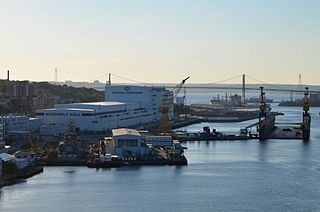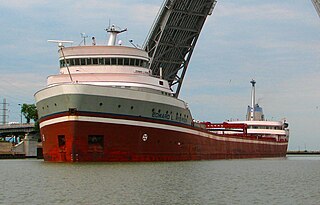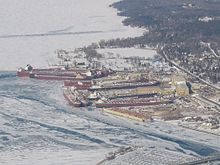
Manitowoc Shipbuilding Company, located in Manitowoc, Wisconsin, was a major shipbuilder for the Great Lakes. It was founded in 1902, with the purchase of the "Burger & Burger Shipyard," a predecessor to The Burger Boat Company, and made mainly steel ferries and ore haulers. During World War II, it built submarines, tank landing craft (LCTs), and self-propelled fuel barges called "YOs". Employment peaked during the military years at 7000. The shipyard closed in 1968, when Manitowoc Company bought Bay Shipbuilding Company and moved their shipbuilding operation to Sturgeon Bay.

The Damen Group is a Dutch defence, shipbuilding, and engineering conglomerate company based in Gorinchem, Netherlands.

SS Badger is a passenger and vehicle ferry in the United States that has been in service on Lake Michigan since 1953. Currently, the ship shuttles between Ludington, Michigan, and Manitowoc, Wisconsin, a distance of 62 miles (100 km), connecting U.S. Highway 10 (US 10) between those two cities. She is the last coal-fired passenger vessel operating on the Great Lakes, and was designated a National Historic Landmark on January 20, 2016.

The SS Christopher Columbus was an American excursion liner on the Great Lakes, in service between 1893 and 1933. She was the only whaleback ship ever built for passenger service. The ship was designed by Alexander McDougall, the developer and promoter of the whaleback design.

The Halifax Shipyard Limited is a Canadian shipbuilding company located in Halifax, Nova Scotia.
The Western Dry Dock and Shipbuilding Company was a shipyard that operated at Port Arthur, Ontario, now part of Thunder Bay, on Lake Superior from 1911 to 1993. The shipyard was established in 1909 and renamed in 1916 as the Port Arthur Shipbuilding Company. The yard closed in 1993. It reopened as a repair yard Lakehead Marine and Industrial, however that venture failed in 2014. As of 2016, the shipyard was purchased by Heddle Marine. It is operated by Heddle Marine in partnership with Fabmar Metals Inc, of Thunder Bay. The venture focuses on ship repair services and winter layup options.
The American Ship Building Company was the dominant shipbuilder on the Great Lakes before the Second World War. It started as Cleveland Shipbuilding in Cleveland, Ohio in 1888 and opened the yard in Lorain, Ohio in 1898. It changed its name to the American Ship Building Company in 1900, when it acquired Superior Shipbuilding, in Superior, Wisconsin; Toledo Shipbuilding, in Toledo, Ohio; and West Bay Shipbuilding, in West Bay City, Michigan. With the coming of World War I, the company also acquired Buffalo Dry Dock, in Buffalo, New York; Chicago Shipbuilding, in Chicago, Illinois; and Detroit Shipbuilding, in Wyandotte, Michigan. American Shipbuilding ranked 81st among United States corporations in the value of World War II military production contracts.

The SS St. Marys Challenger is a freight-carrying vessel operating on the North American Great Lakes built in 1906. Originally an ore boat, she spent most of her career as a cement carrier when much larger ore boats became common. After a 107-year-long working career as a self-propelled boat, she was converted into a barge and paired with the tug Prentiss Brown as an articulated tug-barge. Before conversion, she was the oldest operating self-propelled lake freighter on the Great Lakes, as well as being one of the last freight-carrying vessels on the Great Lakes to be powered by steam engines.

Todd Pacific Shipyards, Los Angeles Division was a shipyard in San Pedro, Los Angeles, California. Before applying its last corporate name, the shipyard had been called Los Angeles Shipbuilding & Dry Dock Company and Todd Shipyards, Los Angeles Division. Under those three names, the San Pedro yard built at least 130 ships from 1917 to 1989.

MV John J. Boland is a diesel-powered lake freighter owned and operated by the Buffalo-based American Steamship Company (ASC), a subsidiary of Rand Logistics. This vessel was built in 1973 at Bay Shipbuilding Company, Sturgeon Bay, Wisconsin. Initially named Charles E. Wilson, the vessel was renamed to its current name in 2000.
Kingston Shipyards was a Canadian shipbuilder and ship repair company that operated from 1910 to 1968. The facility was located on the Kingston waterfront property known as Mississauga Point, which is the now the site of the Marine Museum of the Great Lakes at Kingston.

The Interlake Steamship Company is an American freight ship company that operates a fleet on the Great Lakes in North America. It is now part of Interlake Maritime Services.

MV Roger Blough is a ship built in 1972 by American Ship Building Company in Lorain, Ohio. She serves as a lake freighter on the Great Lakes. The ship is owned by Great Lakes Fleet, Inc. and is named for the former chairman of U.S. Steel, Roger Blough.

Australasia was a wooden-hulled American Great Lakes freighter that served on the Great Lakes of North America between her construction in 1884 to her burning and sinking in 1896. On October 18, 1896, while loaded with coal, the Australasia sank in Lake Michigan near the town of Sevastopol, Door County, Wisconsin, United States, after burning off Cana Island. On July 3, 2013, the wreck of the Australasia was added to the National Register of Historic Places.

SS S.C. Baldwin was a wooden-hulled steam barge built in 1871, that capsized in a storm on August 26, 1908, on Lake Michigan, off Two Rivers, Wisconsin, United States, with the loss of one life. On August 22, 2016 the remnants of S.C. Baldwin were listed in the National Register of Historic Places as reference number 16000565.

SS Edward L. Ryerson is a steel-hulled American Great Lakes freighter that entered service in 1960. Built between April 1959 and January 1960 for the Inland Steel Company, she was the third of the thirteen so-called 730-class of lake freighters, each of which shared the unofficial title of "Queen of the Lakes", as a result of their record-breaking length. She was not only the last steam-powered freighter built on the lakes but also the last one that was not a self-unloader. Since 2009, she has been in long-term layup in Superior, Wisconsin. She is one of only two American-owned straight deck lake freighters, the other being John Sherwin, built in 1958.

Robert C. Pringle, originally named Chequamegon, was a wooden-hulled American tugboat that sank without loss of life on Lake Michigan, near Sheboygan, Wisconsin, on June 19, 1922, after striking an obstruction.

The SS Alpena is a lake freighter. She was built in 1942 by the Great Lakes Engineering Works in Ecorse, Michigan, to carry iron ore. She was originally owned by the Pittsburgh Steamship Company, a subsidiary of United States Steel. After also hauling grain in addition to ore in the 1960s and 1970s, the ship was put into storage in 1982.

Bethlehem Staten Island also called Bethlehem Mariners Harbor was a large shipyard in Mariners Harbor, Staten Island, New York. The shipyard started building ships for World War II in January 1941 under the Emergency Shipbuilding Program and as the result of the Two-Ocean Navy Act of July 1940. The shipyard was part of the Bethlehem Shipbuilding Corporation which built ships for the United States Navy, and the United States Maritime Commission. Bethlehem Steel purchased the shipyard in June 1938 from United Shipyards. Bethlehem Shipbuilding Corporation closed the shipyard in 1959. The propeller factory and foundry continued operation for 10 more years at the site. Since 1980 the site is the May Ship Repair Contracting Corporation next to Shooters Island at the southern end of Newark Bay, off the North Shore.


















